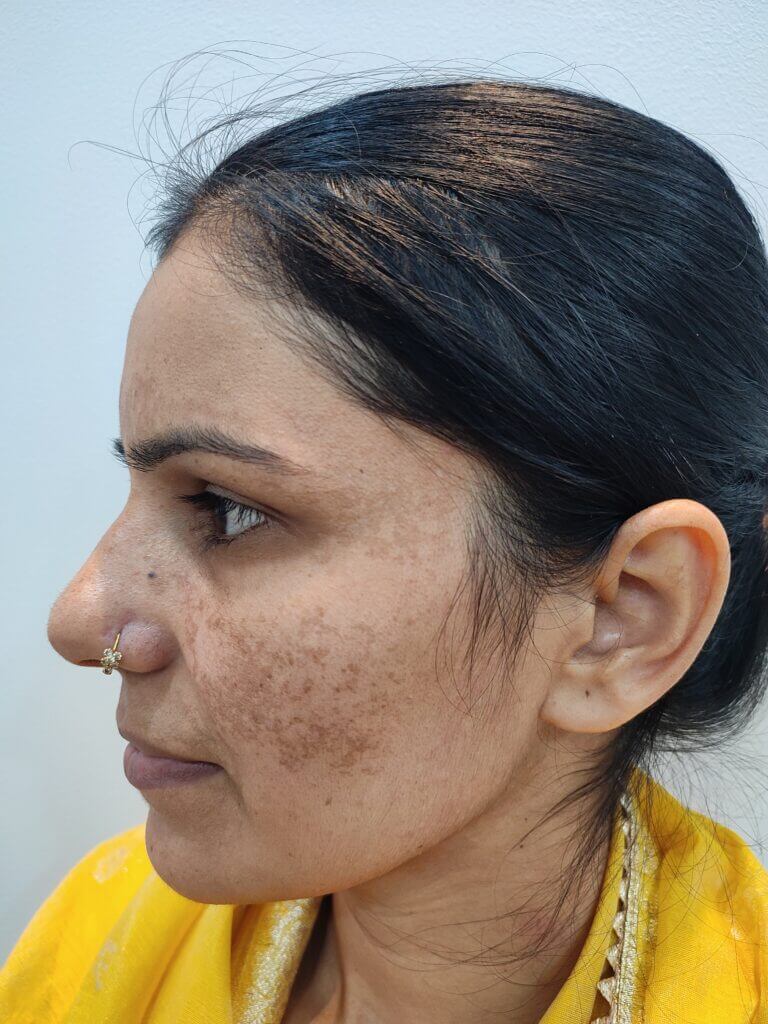Melasma (PIH)
Melasma is a common skin condition marked by dark, discolored patches on the face, often affecting sun-exposed areas like the cheeks, forehead, upper lip, and chin. While harmless, melasma can cause cosmetic concerns due to its visible appearance. At our clinic, we offer the Best Melasma Treatment in Faridabad to help reduce pigmentation and restore an even, radiant complexion.
Understanding Melasma
Melasma occurs when the pigment-producing cells in the skin (melanocytes) produce too much pigment (melanin). Several factors can trigger melasma, including:
- Sun Exposure: Ultraviolet (UV) rays from the sun stimulate melanocytes, leading to increased melanin production.
- Hormonal Changes: Pregnancy, birth control pills, and hormone replacement therapy are common triggers.
- Genetics: Having a family history of melasma may raise your risk of developing the condition.
- Skin Type: Individuals with darker skin tones are more susceptible due to more active melanocytes.


Treatment Options for Melasma
Treating melasma can be challenging, but with the right approach, the appearance of dark patches can be significantly reduced. Our clinic offers a range of effective treatments tailored to your skin type and severity of melasma:
1. Topical Treatments
- Hydroquinone Cream: A popular choice for lightening dark patches, hydroquinone works by inhibiting melanin production. This is often recommended as the first step in treatment.
- Retinoids: These vitamin A derivatives help accelerate cell turnover, which can reduce the appearance of melasma over time.
- Corticosteroids: Sometimes prescribed in conjunction with hydroquinone and retinoids to enhance their effects and reduce inflammation.
- Other Skin Lighteners: Ingredients like azelaic acid, kojic acid, and vitamin C can also help in reducing pigmentation.
2. Chemical Peels
- Glycolic Acid Peels: These peels exfoliate the upper layers of skin, promoting new skin cell growth and reducing pigmentation.
- TCA Peels (Trichloroacetic Acid): A stronger peel that penetrates deeper layers of the skin, offering more significant results for stubborn melasma.
3. Laser and Light Therapies
- Fractional Lasers: This technology targets melanin within the skin, breaking down pigment and promoting even skin tone. It’s effective for more severe cases of melasma.
- IPL (Intense Pulsed Light) Therapy: IPL uses broad-spectrum light to target pigmentation and reduce the appearance of dark patches without damaging surrounding skin.
4. Microneedling
- Microneedling with PRP: This treatment uses tiny needles to create micro-injuries in the skin, stimulating collagen production and improving skin texture. When combined with PRP (Platelet-Rich Plasma), it can enhance skin healing and reduce pigmentation.
Prevention and Maintenance
Preventing melasma from worsening is key to managing the condition. Here are some tips:
- Sun Protection: Use a broad-spectrum sunscreen with SPF 30 or higher daily, even on cloudy days. Reapply every two hours when outdoors.
- Avoid Triggers: If possible, minimize exposure to hormonal triggers and consult with your healthcare provider about alternatives.
- Consistent Skincare Routine: Use gentle, non-irritating skincare products that complement your treatment plan.
Why Choose Us?
At One Skin Clinic, we understand the emotional impact of skin conditions like melasma. Our dermatologists are experts in treating pigmentation disorders and will work closely with you to develop a personalized treatment plan. We combine the latest technologies with compassionate care to help you achieve clearer, more radiant skin.
